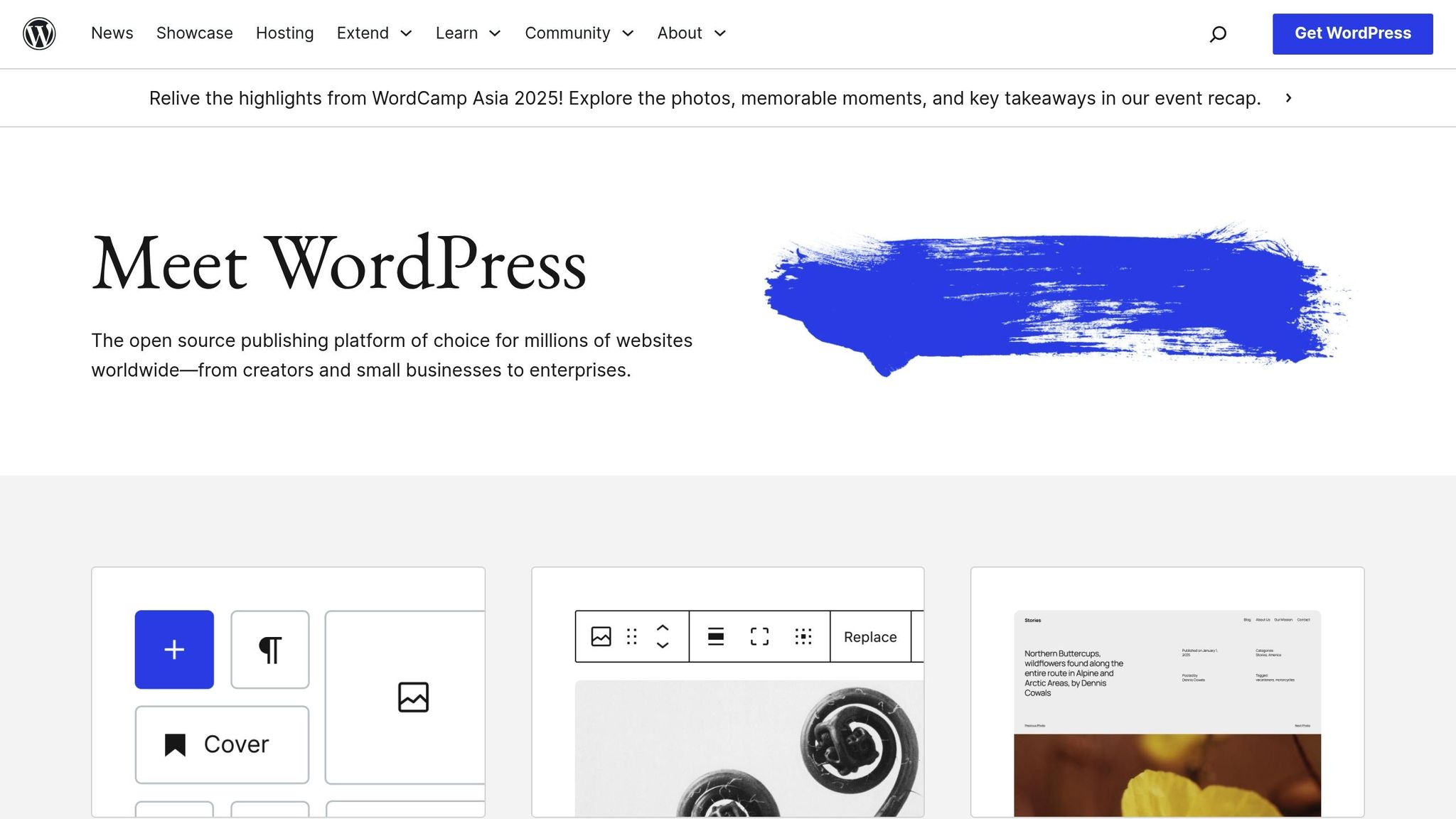How to Choose WordPress Hosting for Small Business

Selecting the right WordPress hosting can directly impact your website’s speed, security, and reliability – key factors for online success. Here’s what you need to know:
- Speed Matters: A 1-second delay can reduce conversions by 7%. Hosting optimized for WordPress ensures faster load times.
- Security is Critical: Over 60% of small businesses hit by cyberattacks shut down within six months. Secure hosting with SSL, backups, and malware protection is essential.
- Uptime and Reliability: A hosting provider with 99.9% uptime minimizes downtime, ensuring your site stays online.
- Shared vs. Managed Hosting:
- Shared Hosting: Budget-friendly ($2–$3/month) but offers basic performance and security.
- Managed Hosting: Higher cost ($25+/month) but includes WordPress-specific optimizations, advanced security, and expert support.
Quick Comparison
| Feature | Shared Hosting | Managed Hosting |
|---|---|---|
| Cost | $2–$3/month | $25+/month |
| Performance | Basic | Optimized for WordPress |
| Security | Basic | Advanced |
| Support | General help | WordPress experts |
| Management | Self-managed | Fully managed |
Key Hosting Features to Look For
- Performance: CDN, caching, and fast server response times.
- Security: SSL, automated backups, malware scans, and firewalls.
- Support: 24/7 availability with WordPress expertise.
- Scalability: Flexible plans that grow with your business.
Choosing a WordPress Hosting Provider in 2025: Step-By …

WordPress Hosting Fundamentals
To optimize your website’s performance and security, it’s crucial to understand the basics of WordPress hosting and the options available.
What WordPress Hosting Does
WordPress hosting relies on a tailored infrastructure designed to improve performance and security. With WordPress powering over 427 million websites, having a hosting setup designed specifically for it is essential.
This type of hosting takes care of important technical tasks, including core software updates, performance tuning, security monitoring, caching specific to WordPress, and database management.
"WordPress hosting is a type of web hosting that comes with the WordPress CMS preinstalled."
Shared vs Managed Hosting: Key Differences
Choosing between shared and managed hosting can have a big impact on your website’s performance and upkeep. Recent stats show that shared hosting accounts for about 40% of the market, while managed WordPress hosting is used by around 35% of WordPress sites.
| Feature | Shared | Managed |
|---|---|---|
| Cost | $2–3/month | $25+/month |
| Performance | Basic | Optimized for WordPress |
| Security | Basic protection | Advanced security |
| Support | General help | WordPress experts |
| Management | Self-managed | Fully managed |
Studies indicate that businesses lose an average of $700,000 annually due to website downtime. Managed hosting offers proactive maintenance, which helps minimize downtime risks.
Grasping these differences helps you choose hosting that aligns with your business requirements.
Must-Have Hosting Features
Your hosting plan should include critical features such as a 99.9% uptime guarantee and strong security and performance tools.
Security and Performance Features:
- Core Protection: SSL certificates, DDoS protection, automated backups, malware scanning, and WordPress-specific firewalls.
- Speed Optimization: CDN (Content Delivery Network) integration and server-side caching.
Efficient caching can make your website 2–5× faster, while CDNs can cut load times by up to 50%. With DDoS attacks rising by 50% annually, investing in robust security measures is more important than ever. Alarmingly, about 60% of hacked WordPress sites result from outdated software.
These features provide the foundation for a hosting solution that supports your business’s growth – something we’ll delve into next.
Determining Your Hosting Needs
Website Traffic Analysis
Understanding your website’s traffic is key to choosing the right hosting plan. Let’s look at an example: In January 2024, GreenThumb Gardens experienced a surge in monthly visitors, jumping from 5,000 to 25,000. Their shared hosting couldn’t handle the load, causing performance issues. Upgrading to a VPS solved the problem.
Here’s how you can assess your traffic needs:
- Track key metrics: Monitor unique visitors, page views, and peak usage times.
- Measure engagement: Look at average session duration and pages per visit.
- Plan for growth: Factor in anticipated traffic increases from campaigns or seasonal trends.
These insights help you estimate the resources your hosting plan should support.
Resource Requirements
When it comes to hosting, understanding your resource needs is crucial. Here’s a quick breakdown:
| Resource Type | Typical Requirements | Recommended Buffer |
|---|---|---|
| Storage Space | OS (5GB) + Database (10GB) + Email (5GB) | Keep 15% free space |
| RAM | OS (1GB) + Database (2GB) + Apps (1GB) | Add 20% overhead |
| Bandwidth | Monthly visitors × Average page size | Plan for 50% growth |
For example, a standard WordPress page averages around 25KB. To maintain optimal performance, aim to keep your disk usage below 85% of its total capacity.
Business Goals and Hosting Features
Once you’ve nailed down your traffic and resource requirements, focus on hosting features that support your business objectives.
Here’s how hosting features align with common goals:
-
Performance needs:
- E-commerce sites need robust processing for transactions.
- Content-heavy websites require extra storage and bandwidth.
- Membership platforms benefit from enhanced security.
-
Growth readiness:
- Opt for plans that allow easy resource upgrades.
- Ensure scalability to handle traffic spikes.
- Consider future feature additions.
Don’t overlook uptime guarantees. A minimum uptime of 99.9% is critical for maintaining customer trust and ensuring revenue isn’t lost due to downtime.
sbb-itb-d55364e
Speed, Security, and Support Standards
Speed and Uptime Guarantees
Did you know a one-second delay in loading time can lower conversions by 7%, and a three-second delay could cost you half your traffic?. That’s why hosting performance metrics matter so much. Here are the key ones to focus on:
| Performance Metric | Industry Standard | Impact on Business |
|---|---|---|
| Uptime Guarantee | At least 99.9% | About 8 hours of downtime per year |
| Server Response Time | Less than 200ms | Directly impacts page load speed |
| Page Load Time | Under 3 seconds | Affects bounce rate significantly |
To maintain top performance, consider using real-time monitoring tools and content delivery networks (CDNs). But speed isn’t the only priority – keeping your website secure is just as important.
Website Protection Features
Once your site is running fast, the next step is ensuring it’s secure. With 41% of WordPress sites compromised due to hosting server vulnerabilities, your hosting plan must include strong protection measures.
Here’s what to look for in a hosting provider:
- Advanced server-level protection with firewalls and intrusion detection systems.
- Automated backups that are easy to restore in case of emergencies.
- SSL certificates and automated scans to detect and address security risks continuously.
Make sure your hosting provider also applies regular security updates and patches to their servers. With your site protected, the final piece of the puzzle is reliable technical support.
Technical Support Quality
Fast support can mean the difference between a minor hiccup and a major disruption. When evaluating technical support, pay attention to response times and the expertise of the support team.
Here’s what you should expect:
| Support Aspect | Standard | Best Practice |
|---|---|---|
| Critical Support | 30-minute response | Immediate response |
| Regular Tickets | 24-hour response | 4-hour response |
| Support Hours | Business hours | 24/7/365 availability |
| Support Channels | Email + Chat | Email + Chat + Phone |
Look for hosting providers with WordPress-specific support teams who can help with platform-related issues, from performance tweaks to security fixes.
"When setting up your website as a beginner, having expert WordPress Hosting support can be a lifesaver to help keep your site running smoothly and resolve issues as quickly as possible." – Hosted.com Article
Lastly, choose a provider that offers detailed guides and self-help resources. This ensures you can find answers whenever you need them, no matter the time or situation.
Price and Growth Planning
Hosting Plan Costs
When choosing a hosting plan, compare monthly prices and long-term value. Entry-level shared hosting typically costs between $2.95 and $4.99 per month, but these promotional rates often require an annual commitment.
| Cost Category | Monthly Range | What’s Included |
|---|---|---|
| Basic Shared Hosting | $2.95 – $4.99 | Essential features with limited resources |
| Business-Grade Hosting | $7.99 – $14.99 | Better performance and customer support |
| Premium Managed WP | $15.99 – $29.99 | Fully managed services with advanced functionalities |
Choose a plan that fits your budget while keeping future growth in mind.
Growth-Ready Hosting Options
Your hosting requirements will change as your website grows. Here’s a typical progression:
| Growth Stage | Recommended Type | Scalability |
|---|---|---|
| Startup | Shared Hosting | Basic |
| Growing Business | VPS Hosting | Moderate |
| Established Brand | Cloud Hosting | High |
Start small with shared hosting, then move to VPS or cloud hosting as your traffic and needs increase.
Extra Costs to Watch For
In addition to hosting fees, consider these potential extra expenses:
| Extra Cost | Annual Range | Notes |
|---|---|---|
| Domain Privacy | $5 – $15 | Keeps your business information private |
| SSL Certificate | $8 – $100 | Ensures secure data transmission |
| Backup Solutions | $60 – $360 | Protects your data from loss |
| Security Tools | $240 – $360 | Includes firewalls and malware protection |
To manage your hosting budget effectively:
- Lock in promotional rates by opting for longer billing cycles.
- Bundle services to save money on extras.
- Keep an eye on resource usage to avoid unnecessary overcharges.
- Check renewal terms to prevent unexpected price increases.
Planning for these costs will help you choose a hosting plan that supports your current needs and grows with your business.
Summary: Your Hosting Choice Checklist
Here’s a checklist to help you evaluate and choose the right hosting provider based on the key points we’ve discussed:
Key Features to Confirm
| Category | Must-Have Elements | Why It Matters |
|---|---|---|
| Security | SSL, DDoS protection, backups | Safeguards your data and reputation |
| Performance | CDN, SSD, caching | Delivers fast loading and smooth usage |
| Support | 24/7 availability, multiple channels | Reduces downtime and resolves issues quickly |
| Scalability | Flexible resources, upgrade options | Supports growth without interruptions |
Technical Requirements to Check
Make sure your hosting provider meets these technical benchmarks:
- Uptime: Look for a minimum 99.9% uptime guarantee.
- Server Response: Ensure servers are optimized for quick load times.
- Backups: Confirm automated backups are in place.
- WordPress Optimization: If you’re using WordPress, the hosting environment should be tailored for it.
Budgeting Tips
Plan your hosting budget with both current needs and future growth in mind:
- Compare introductory rates with renewal costs.
- Account for additional expenses like security upgrades, backups, and domain privacy.
Evaluating Support Quality
Strong support can make all the difference. Look for these indicators:
- Response Time: Quick replies to your queries.
- Communication Channels: Availability via chat, phone, and email.
- Specialized Expertise: Team members knowledgeable in WordPress-specific issues.
- Self-Help Resources: Access to guides, tutorials, and a detailed knowledge base.
Research shows that hosting providers with a 98% satisfaction rate often deliver a better overall support experience.
Use this checklist as a practical tool to narrow down your options and pick a hosting plan that aligns with your business needs.
